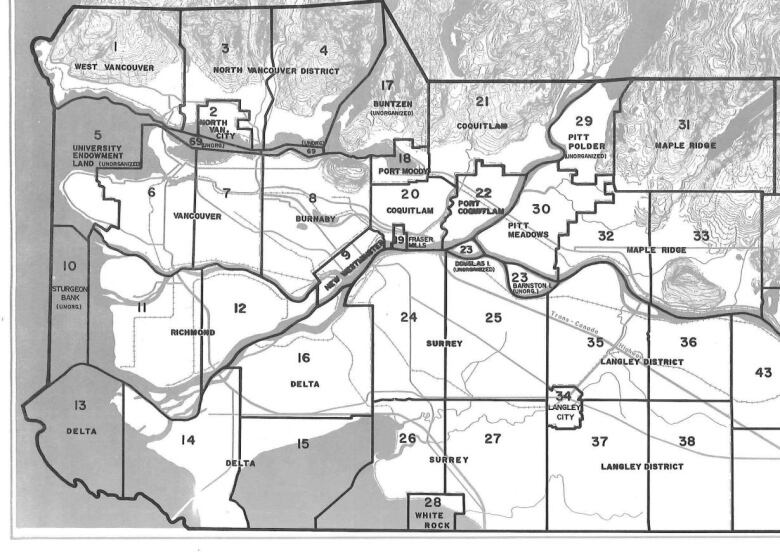Why Metro Vancouver is unlikely to reduce its 21 municipalities anytime soon
So long as smaller jurisdictions are treated equally in referendums, there's little incentive for change

There's the City of Langley and the Township of Langley. The District of North Vancouver and the City of North Vancouver. The "Tri-Cities" region, which actually includes five separate municipalities. City halls that oversee 600,000 peopleand city halls that oversee 600.
If you've lived in Metro Vancouver for your entire life, you takeits hodgepodge of local governments for granted. But in the rest of the country, highly populated areas have always been comprised ofone dominant cityor have been merged into one at some point in the last century.
Metro Vancouver's uniquearrangement means the idea of reducing the number of municipalities regularly comes up. But there are a number of reasons why it's unlikely to change.
Let's start at the beginning
The mix ofrivers, inlets, mountains and farmland in southwest B.C. meant that when people of European descent settled here in the second half of the 19th century, they did so at several strategic points all at a fair distance from one another rather than concentrate in one particular area.
So when B.C. allowed areas to start "incorporating" (the fancy name for a place becoming its own municipality), it happened in a piecemeal fashion: New Westminster began as nothing more than a small collection of blocks along the Fraser in 1860 but was joined by Langley in 1873, Maple Ridge in 1874, Richmond in 1879, North Vancouver in 1891 and so on.
But in the 20th century,new municipalities were createdwhen small parts of a large municipality wanted to split away to ensure greater local control, including West Vancouver in 1912, Port Moody and Port Coquitlam in 1913,White Rock in 1957andLangley City in 1955.

A mall divided against itself ...
"We weren't getting urban services and we thought that our voice wasn't being heard," said Nathan Pachal, a Langley City councillor, who explained that the big issue prompting the city to separatewas the rural voters in the township not wanting to pay for streetlights.
Which was a perfectly logical reason for the City of Langley to be created in 1955.But now everyone has streetlights.
And the city is now surrounded by the Willoughby and Brookswood neighbourhoods to the north and south (both in the township), and Clayton and Cloverdale to the west (both in Surrey).
In fact, there's even a building that goes through both Langleys: theWillowbrookShopping Centre, where The Bay has to file paperwork with both the township and the city.
Autonomy and finances
While people outside the Langleys may think it makes sense for them to merge, B.C. is hands off with its municipalities and requires any amalgamation to have the support of 50 per cent of voters in each of the affected districts.
"We're debt free," said City of Langley Mayor Val van den Broek, when askedwhy none of her council were in support of unification.
"The way I always say it to people is I've got a credit card,you've got a credit card. Why would I pay your credit card off, before I would pay my own credit card off?"
Finances and the fear of losing autonomy are generally cited by politicians in smaller municipalities in rejecting amalgmation overtures from their larger neighbour.
Fewer mayors less spending
But wouldn't reducing the number of city halls reduce overall costs? Not necessarily.
The Fraser Institute has done studies arguing merged municipalities have higher labour costs that cancel outsavings made through eliminating redundancies, and a study done before anamalgmationreferendumfor North Cowichan and Duncan estimated there would be minimal financial change if those municipalities merged.
"You would never design it like this," said Jordan Bateman, VP for the Independent Contractors andBusinesses Associationand a Langley Township councillor the last time amalgamation was significantly considered.
"However, it does force a little bit of property tax competitiveness, because no one can go too far in increasing taxes without losing businesses to other places."
In addition, a strong regional government system (in the form of Metro Vancouver for utilities, and the Mayors' Council for transportation) ensures that some of the broader issues that amalgamationproponents bring up in other cities are already dealt with even in the region's smallest municipalities.
"We get that benefit of scale where it matters, and then we get the benefit of local autonomy," said Pachal.
"So I think we have the best of both worlds."












_(720p).jpg)


 OFFICIAL HD MUSIC VIDEO.jpg)
.jpg)



























































































